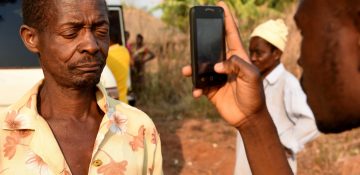Our approach
The approach to successfully implement SDR-PEP considers four crucial elements: active case finding, geological mapping, capacity building of health workers and distribution.

The ongoing transmission of leprosy is the product of a complex set of challenges, which requires a multi-faceted approach. In this project, we aim to interrupt the spread and devastating mutilating effects of leprosy in Mozambique and Nigeria, through well thought-out interventions targeting a range of stakeholders. The governments of both countries have shown enthusiasm and willingness to work together with the partners in this project to introduce SDR-PEP into their leprosy control programmes, and improve care for persons affected.
Active case finding
Implementing SDR-PEP goes hand-in-hand with active case finding in the form of contact examination, which will lead to an increased number of early identified leprosy patients. Active case finding campaigns are often short-term interventions in specified, relatively small areas and consist of activities such as door-to-door screening campaigns, school screening, or rapid village surveys.
Contact examination is a form of active case finding that is targeted at high-risk groups. Contacts of untreated leprosy patients (household contacts, neighbours and social contacts) are at highest risk of developing leprosy. Screening contacts for early signs and symptoms of leprosy is in itself a cost-effective approach. Contacts can either be examined during house visits, through an invitation to the health centre or at a community event like a skin camp, where a gender sensitive approach is used to screen community contacts for both leprosy as well as other skin diseases. This approach lowers the threshold for seeking medical care.
Epidemiological mapping
The geographical mapping of leprosy patients is also an important component, which can help to identify patient clusters and target interventions in a cost effective manner. Village level mapping will be done of leprosy patients on treatment, those that were treated in the past few years, and the new patients that are identified through active case finding activities. This will provide better insight in the distribution of leprosy in the project areas, which helps to identify the number of people that should receive SDR-PEP. Unfortunately, village level mapping of leprosy patients is not routinely done as part of the governmental recording and reporting systems and therefore requires an additional effort and guidance from NLR.
Building capacity of health workers
There is a significant shortage of specialized medical care in Africa. Health workers often lack the knowledge on the recognition of early signs and symptoms of leprosy as well as on management of the disease. In addition, health workers’ attitudes were found to be unfavourable towards leprosy suspects and people affected by leprosy.
It is for this reason that an important component of any project on leprosy includes capacity building of the health workers that are in direct contact with patients, in order to train them not only on the physical signs and symptoms, but also on their behaviour towards those patients. This is why every training or workshop will include a crucial element of addressing stigma and discrimination directed to leprosy patients.
Skin examination offers an opportunity to screen people and to identify multiple conditions at an early stage. An integrated community approach is promoted by the WHO as it can potentially reduce costs and promote dermatological health. A number of studies have demonstrated the potential and usefulness of mobile health (mHealth) or electronic health (eHealth) in low-resource settings. Using mHealth or eHealth solutions is beneficial to health workers, patients, and health care delivery systems.
As an important tool in the capacity building on diagnosis, NLR, in collaboration with Erasmus Medical Centre, has developed an application, called SkinApp, which supports peripheral health workers with limited dermatological knowledge in recognising the crucial early signs and symptoms of leprosy and other skin diseases. The SkinApp uses an algorithm to support the process of diagnosis and contains descriptions of skin diseases, dermatological photos, as well as treatment and referral advice.
SDR-PEP distribution
The distribution of SDR-PEP to the contacts of confirmed leprosy patients is another crucial element. Leprosy patients that were diagnosed in the past three years will be mapped and visited by heath care workers. After providing consent, this health care worker will list their direct contacts and visit them. After receiving the contacts’ consent, the health worker will visit each contact and screen them for signs and symptoms of leprosy. Those contacts that do not display signs and symptoms of the disease, and meet the eligibility criteria for SDR-PEP administration, will receive a single dose of rifampicin. Should a new case be suspected of having leprosy during contact examination, then this patient will be referred to a local clinic to confirm the diagnosis and start MDT treatment. The contacts of this new patient will then also be screened for leprosy, continuing the cycle.